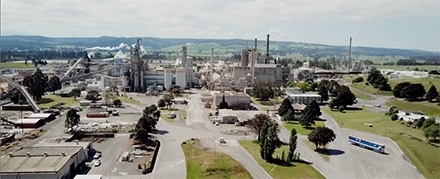
Australian Paper is moving ahead with its five-year, $200 million capital investment program at its Maryvale paper mill in Victoria’s Latrobe Valley. The company committed $51 million in the second year of the program to upgrade key strategic infrastructure, according to AP’s 2018 Sustainability Report. Source: Philip Hopkins for Timberbiz
These investments, which will boost production and efficiency, include:
- $17.5 million on the upgrade of the R5 recovery boiler, which is a key piece of the power generation infrastructure that makes the Maryvale Mill Victoria’s largest producer of baseload renewable energy.
- $15m on the rebuild of the M4 Wet End, Maryvale’s largest paper machine that produces 225,000 tonnes per annum of high-quality board for Australia’s surging packaging market.
- $5.5m on restoration of the Lime Kiln, which is 106 metres long, operates at 1000 degrees Centigrade and is central to the factory’s chemical recovery process.
The strategic investment is one of four main elements being developed by AP to secure its future. The other three are global competitiveness, innovation and a sustainable fibre supply, says the sustainability report.
To remain globally competitive, AP’s planned $600 million Energy from Waste plant at the Maryvale site aims to provide base load energy security to the paper mill in the face of rising gas and electricity costs.
Being developed in partnership with Suez Recycling and Recovery, the plant will generate 225 megawatts of thermal energy – steam – to help run the mill. About 650,000 tonnes per annum of non-hazardous residual waste is required to run the plant – waste that would otherwise be sent to landfill.
The plan is to use municipal solid waste (MSW) for about 80% of the fuel output to the EfW plant, sourced from long-term contracts with councils, mainly in south-east Melbourne and Gippsland. MSW is waste from household rubbish, not recyclable collections. The remaining 20 per cent will come from commercial and industrial waste.
AP says the plant will reduce Victoria’s net emissions by about 543,000 tonnes annually. The technology has received the approval of the Environment Protection Authority.
The report says the BioPathways Partnership with Federation Training and Federation University, is a key innovation plank, designed to support Gippsland’s future biomanufacturing training needs.
“The project aims to develop accredited biomanufacturing training to support a Gippsland bioeconomy and future opportunities for Australian Paper,” the report says.
The Maryvale mill produces more than 600,000 tonnes of lignin-based biofuel annually.
“In the future, this could be processed into a range of new generation bio-products,” the report says. These include substitutes for plastics, complex chemicals and fuels and carbon fibre.
Australian Paper is also investigating with Mainstream Aquaculture a potential aquaculture plant in the Latrobe Valley. The facility would operate separately, leveraging Maryvale’s oxygenation, water heating and water treatment capacity. A feasibility study is expected to be announced later this year.
The sustainability report notes that the Maryvale paper mill uses just under 1.7m tonnes of certified wood per year, with 68% plantation timber, 26% regrowth native timber from VicForests, and 6% from sawmill wood chip residues.
It points out Victoria’s high level of biodiversity protection. The United Nations Convention on Biological diversity has an international target for at least 17% of forests to be protected for biodiversity. In Victoria, 85% is managed for biodiversity protection – well above the international target of 17%, the sustainability report says.






